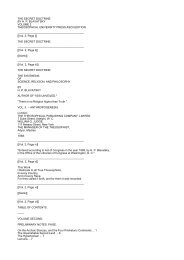Create successful ePaper yourself
Turn your PDF publications into a flip-book with our unique Google optimized e-Paper software.
Plate I.<br />
Hymne à Ammon-Ra, p. 264, note 2; Pierret, Panthéon, pp. 74, 75; Lefébure, Traduction Comparée des Hymnes au Soleil,<br />
p. 39; De Rougé, Inscription d'Ahmés, p. 110; Archaeologia, vol. 52, p. 541 ff.; Wiedemann, Die Religion der Alten<br />
Aegypter, p. 17; Brugsch, Religion und Mythologie, p. 245, etc.<br />
3. The goddess Nut represented <strong>the</strong> sky, and perhaps also <strong>the</strong> exact place where <strong>the</strong> sun rose. She was <strong>the</strong> wife <strong>of</strong> Seb, <strong>the</strong><br />
Earth-god, and gave birth to Isis, Osiris, and o<strong>the</strong>r gods. One <strong>of</strong> her commonest titles is "mo<strong>the</strong>r <strong>of</strong> <strong>the</strong> gods." She is<br />
depicted as a woman bearing a vase upon her head, and sometimes wears <strong>the</strong> disk and horns usually characteristic <strong>of</strong> Isis<br />
and Hathor. She was <strong>the</strong> daughter and mo<strong>the</strong>r <strong>of</strong> Ra. See Lanzone, Dizionario, p. 392; Pierret, Panthéon, pp. 34, 36;<br />
Brugsch, Religion und Mythologie, pp. 603-610.<br />
4. Manu is <strong>the</strong> name given to <strong>the</strong> mountains on <strong>the</strong> western bank <strong>of</strong> <strong>the</strong> Nile, opposite Thebes, wherein was situated tu<br />
Manu, "<strong>the</strong> mountain <strong>of</strong> Manu," <strong>the</strong> chief site <strong>of</strong> rock-hewn tombs. See Brugsch, Dict. Géog., p. 259.<br />
5. Maat, "daughter <strong>of</strong> <strong>the</strong> Sun, and queen <strong>of</strong> <strong>the</strong> gods," is <strong>the</strong> personification <strong>of</strong> righteousness and truth and justice. In<br />
many papyri she is represented as leading <strong>the</strong> deceased into <strong>the</strong> Hall <strong>of</strong> Double Maat, where his heart is to be weighed<br />
against her emblem. She usually wears <strong>the</strong> fea<strong>the</strong>r, emblematic <strong>of</strong> Truth, and is called <strong>the</strong> "lady <strong>of</strong> heaven": see Lanzone,<br />
Dizionario, p. 276 (and tav. 109, where <strong>the</strong> twin-goddesses Maat are shown); Pierret, Panthéon, p. 2011. She is sometimes<br />
represented blind-fold: see Wiedemann, Religion der alten Aegypter, p. 78. For figures <strong>of</strong> <strong>the</strong> goddess in bronze and stone,<br />
see Nos. 380, 383, 386, II, 109, and II, 114 in <strong>the</strong> British Museum.<br />
6 Heru-khuti, i.e., "Horus <strong>of</strong> <strong>the</strong> two horizons," <strong>the</strong> Harmachis <strong>of</strong> <strong>the</strong> Greeks, is <strong>the</strong> day-sun from his rising in <strong>the</strong> eastern<br />
horizon to his setting in <strong>the</strong> western horizon; for <strong>the</strong> various forms in which he is represented, see Lanzone, Dizionario,<br />
tav. 129. Strictly speaking, he is <strong>the</strong> rising sun, and is one <strong>of</strong> <strong>the</strong> most important forms <strong>of</strong> Horns. As god <strong>of</strong> mid-day and<br />
evening he is called Ra-Harmachis and Tmu-Harmachis respectively. The sphinx at Gizeh was dedicated to him.]<br />
{p. 247}<br />
ka[1] <strong>of</strong> Osiris,[2] <strong>the</strong> scribe Ani, triumphant[3] before Osiris, (6) who saith: Hail all ye gods <strong>of</strong> <strong>the</strong><br />
Temple <strong>of</strong> <strong>the</strong> Soul,[4] who weigh heaven and earth in <strong>the</strong> balance, and who provide food and abundance<br />
<strong>of</strong> meat. Hail Tatunen,[5] One, (7) creator <strong>of</strong> mankind and <strong>of</strong> <strong>the</strong> substance <strong>of</strong> <strong>the</strong> gods <strong>of</strong> <strong>the</strong> south and<br />
<strong>of</strong> <strong>the</strong> north, <strong>of</strong> <strong>the</strong> west and <strong>of</strong> <strong>the</strong> east. Ascribe [ye] praise unto Ra, <strong>the</strong> lord <strong>of</strong> heaven, <strong>the</strong> (8) Prince,<br />
Life, Health, and Strength, <strong>the</strong> Creator <strong>of</strong> <strong>the</strong> gods, and adore ye him in his beautiful Presence as he<br />
riseth in <strong>the</strong> atet[6] boat. (9) They who dwell in <strong>the</strong> heights and <strong>the</strong>y who dwell in <strong>the</strong> depths worship<br />
<strong>the</strong>e. Thoth[7] and Maat both are thy recorders. Thine enemy[8] is given to <strong>the</strong> (10) fire, <strong>the</strong> evil one hath<br />
fallen; his arms are bound, and his legs hath Ra taken from him. The children <strong>of</strong> (11) impotent revolt<br />
shall never rise up again.<br />
[1. According to <strong>the</strong> Egyptian belief man consisted <strong>of</strong> a body xa, a soul ba, an intelligence xu, and ka, The word ka means<br />
"image," <strong>the</strong> Greek ei?'dolon (compare Coptic kau Peyron, Lexicon, p. 61). The ka seems to have been <strong>the</strong> "ghost," as we<br />
should say, <strong>of</strong> a man, and it has been defined as his abstract personality, to which, after death, <strong>the</strong> Egyptians gave a<br />
material form. It was a subordinate part <strong>of</strong> <strong>the</strong> human being during life, but after death it became active; and to it <strong>the</strong><br />
<strong>of</strong>ferings brought to <strong>the</strong> tomb by <strong>the</strong> relatives <strong>of</strong> <strong>the</strong> dead were dedicated. It was believed that it returned to <strong>the</strong> body and<br />
had a share in its re-vivification. See Birch, Mémoire sur une patère Égyptienne (in Trans. Soc. Imp. des Antiquaires de<br />
France, 1858; Chabas, Papyrus Magique, pp. 28, 29; Maspero, Étude sur quelques peintures, p. 191 ff.; Trans. Soc. Bibl.<br />
Arch., vol. vi., p. 494 ff.; Brugsch, Aegyptologie, p. 181; Wiedemann, Religion der alien Aegypter, p. 126 f.).<br />
2 The deceased is always identified with Osiris, or <strong>the</strong> sun which has set, <strong>the</strong> judge and god <strong>of</strong> <strong>the</strong> dead. As <strong>the</strong> sun sets in<br />
<strong>the</strong> west and rises again in <strong>the</strong> cast, so <strong>the</strong> dead man is laid in his tomb on <strong>the</strong> western bank <strong>of</strong> <strong>the</strong> Nile, and after being<br />
acquitted in <strong>the</strong> Hall <strong>of</strong> judgment, proceeds to <strong>the</strong> east to begin a new existence.<br />
3. maaxeru or maatxeru. On this word, see Naville, Litanie du Soleil, p. 74; Devéria, L'Expression Mââ-xerou (in Recueil<br />
de Travaux, tom. i., p. 10 ff.).<br />
4. Compare ### and ### Brugsch, Dict. Géog., pp. 185, 186.<br />
5. Tatunen, or Tenen was, like Seb with whom he was identified, <strong>the</strong> god <strong>of</strong> <strong>the</strong> earth; his name is <strong>of</strong>ten joined to that <strong>of</strong><br />
http://www.sacred-texts.com/egy/ebod/ebod13.htm (2 <strong>of</strong> 6) [8/10/2001 11:24:37 AM]

















